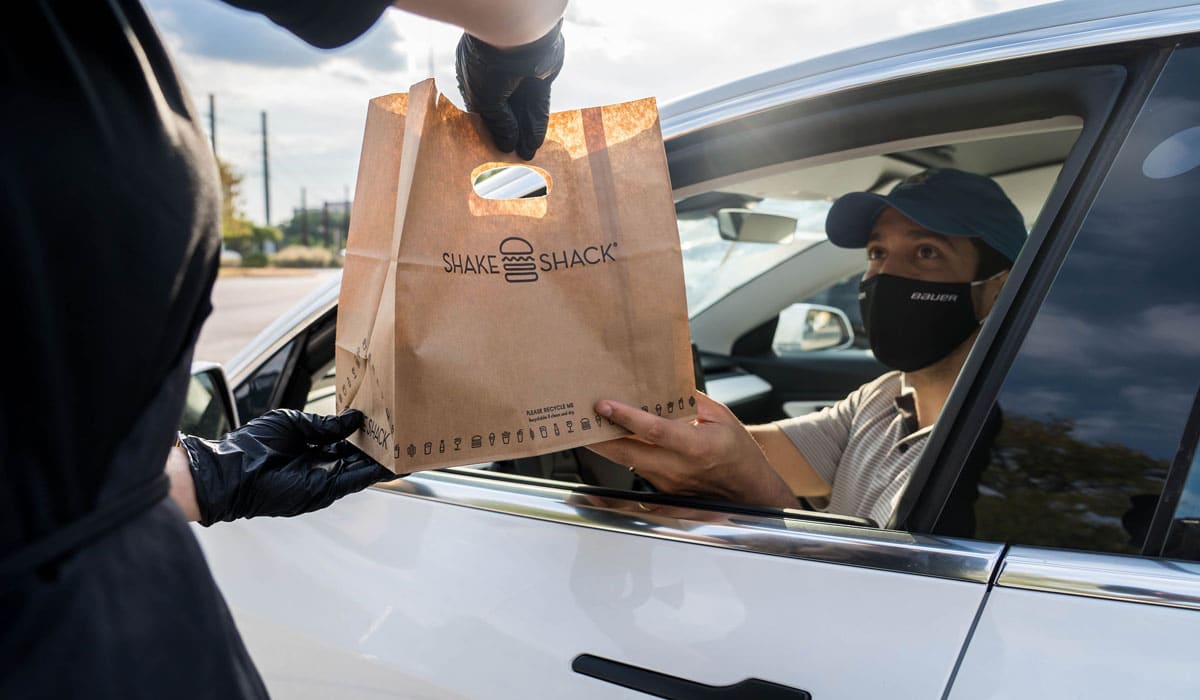Despite COVID-19-related dining restrictions being lifted throughout the country, Shake Shack is still having trouble getting people in the door.
With fewer people roaming the streets of urban areas like downtown Manhattan, the New York City-based burger chain has struggled to recapture pre-pandemic numbers at many of its urban units.
“There’s no question, our hardest hit Shacks are midtown, are downtown Chicago, not just New York,” CEO Randy Garutti said Thursday during the brand’s earnings call. “It is those places that are driven by offices, events, tourism, Broadway, some of our busiest Shacks in the world continue to be down significant numbers.”
Garutti said the lack of international tourism is part of the reason why sales at some urban venues are down. Without tourists, international and domestic alike, Shacks in destination hot spots have struggled.
“Recovery in our urban Shacks still presents the greatest opportunity to recapture sales,” Katie Fogertey, CFO said.
Q2 same-store sales overall were down almost 12 percent compared to the 2019 period, a slight improvement from the 15 percent drop in April of this year versus April 2019. The fast casual finished the fiscal month of July down 9 percent from the prior-year quarter in 2019. Q2 same-store sales were 52.7 percent better than 2020’s COVID lap.
Even with the reopening of units in Union Station (D.C.) and Grand Central Terminal (NYC), Shake shack executives expect recovering the lost sales will be a slow process.
“These two Shacks depend on urban transit,” Fogertey said. “They’ll probably weigh on results in the interim, but it was important to get them reopened and operating as we head into the fall and winter.”
The numbers aren’t all bad, however. Sales at stores in the Southeast region, like those in Texas, are above 2019 averages for the same period. Company-wide sales ($187.5 million) are up 104 percent compared to Q2 2020. Fogertey pointed to the brand’s digital presence as reason for optimism.
“We’re encouraged by the double-digit year-on-year growth of our digital sales, even as our in-Shack sales improved over 300 percent year-on-year in the second quarter,” Fogertey said. “While in-Shack sales have started to come back, our digital retention stayed strong at approximately 80 percent in fiscal June versus fiscal January 21 when digital had hit its peak.”
Despite the still-challenged quarter, Shake Shack has no plans of slowing its growth anytime soon. The company opened 20 domestic company-operated units this year, with another 15–18 coming down the pipe by the end of 2021, the majority of them expected Q4. The chain will also be opening the first Shack drive-thru later this year, with a commitment of opening 10 more drive-thrus in 2022. Licensing has also provided a boon for expansion prospects.
“Our expansion has been filled with dynamic openings,” she said, “including our first Shack in Shenzhen in China, our third in Beijing and our first in the Istanbul Airport. We’ve opened 15 new licensed Shacks so far this year.”
She said, “due to better-than-expected development conditions in Asia,” another 20–25 licensed Shacks can be expected throughout the region in 2022.
“We have a strong focus on the Asia Pacific region,” Fogertey added. “Following successful openings in Shenzhen, Macau, Beijing, Shanghai and Hong Kong, our partner in the region plans to continue the momentum in China with an expanded partnership to open more Shacks across the country over the next 10 years with new development agreements now signed across Central and South China, including the cities of Chengdu and Guangzhou.”
Food and paper costs were up 70 basis-points from the previous quarter, which Fogertey attributed to the inflated cost of beef. Increased food and paper costs coupled with precautionary measures related to the ongoing industry-wide staffing challenges mean guests of the brand can expect to see menu prices rise during Q4 between 3–3.5 percent.
“This is higher than the approximately 2 percent menu price we have historically taken at the end of most calendar years,” Fogertey said. We’ll be evaluating the need for further price increases that might go into effect in 2022, depending on how the cost landscape evolves through the rest of the year.”
Shake Shack also recently introduced a 10 percent premium on third-party delivery orders.
Newly introduced menu items like The Hot Honey Chicken Sandwich, Hot Honey Chicken Bites, and the Triple Chocolate Chip milkshake have proved successful. The chicken sandwich has had a 10 percent attach rate since it launched. Fogertey believes successful LTOs and premium additions are viable strategies for increasing sales.
“The hot honey chicken, the bites … all of these drive a higher ticket,” Fogertey said. “It’s a consumer wanting to add on the avocado, wanting to add on the bacon. Those are ways to more organically grow the check rather than just arbitrarily throwing 5% or 6% price across the board.”










